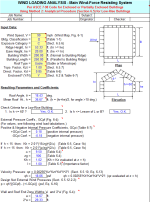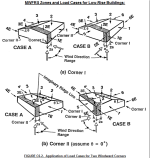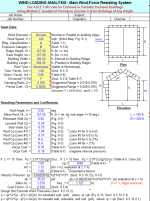ASCE798W.xls

Description
Calculation Description:
"ASCE798W" is a spreadsheet program written in MS-Excel for the purpose of wind loading analysis for buildings and structures per the ASCE 7-98 Code. Specifically, wind pressure coefficients and related and required parameters are selected or calculated in order to compute the net design wind pressures.
This program is a workbook consisting of eight (8) worksheets, described as follows:
- Doc - This documentation sheet
- Simplified - Analysis using simplified method for low-rise buildings with h <= 30’
- MWFRS (Low-Rise) - Main Wind-Force Resisting System for low-rise buildings with h <= 60’
- MWFRS (Any Ht.) - Main Wind-Force Resisting System for buildings of any height
- Wall C&C - Analysis of wall Components and Cladding
- Roof C&C - Analysis of roof Components and Cladding
- Stacks & Tanks - Analysis of cantilevered chimneys, stacks, and vertical tanks
- Wind Map - Basic wind speed map (Figure 6-1 of ASCE 7-98 Code)
Program Assumptions and Limitations:
1. This program assumes only enclosed or partially enclosed buildings. Open buildings are NOT considered.
2. Worksheet for Simplified analysis is applicable for buildings meeting the criteria of Section 6.4.1.
3. In the worksheet for Simplified analysis, the design MWFRS wind load is calculated for each direction. This design load is assumed equal to 1/2 of the total load, as 1/2 is assumed to be taken at roof level and the other 1/2 is taken at the base of the building.
4. Worksheet for MWFRS (Low-Rise) is applicable for low-rise buildings as defined in Section 6.2.
5. Worksheets for MWFRS (Any Ht.), Wall C&C, and Roof C&C are applicable for buildings with mean roof heights of up to 500 feet.
6. Worksheet for Stacks & Tanks is applicable for cantilevered structures up to 600 feet tall.
7. Worksheets for Wall C&C and Roof C&C are applicable for flat roof buildings, gable roof buildings with roof angles <= 45 degrees, and monoslope roof buildings with roof angles <= 3 degrees.
8. Worksheets for MWFRS (Any Ht.) and for Stacks & Tanks can handle “rigid” as well as “flexible” buildings and structures. For “rigid” buildings or structures, this program uses the smaller value of either 0.85 or the calculated value from Section 6.5.8.1 of the Code for the gust effect factor, 'G'. For “flexible” buildings or structures, this program calculates the gust effect factor, ‘Gf’, per Section 6.5.8 of the Code based on the assumed formula for the fundamental period of vibration from Section 9.5.3.3 of the Code.
9. This program uses the equations listed in the reference, “Guide to the Use of the Wind Load Provisions of ASCE 7-98” for determining the external wind pressure coefficients, ‘GCp’, used in the Wall C&C and Roof C&C worksheets.
10. This program contains numerous “comment boxes” which contain a wide variety of information including explanations of input or output items, equations used, data tables, etc. (Note: presence of a “comment box” is denoted by a “red triangle” in the upper right-hand corner of a cell. Merely move the mouse pointer to the desired cell to view the contents of that particular "comment box".)
Calculation Reference
ASCE
|Find on Amazon.com | Find on Amazon.co.uk | Find on Amazon.fr | Find on Amazon.de | Find on Amazon.ca |
Calculation Preview
Full download access to any calculation is available to users with a paid or awarded subscription (XLC Pro).
Subscriptions are free to contributors to the site, alternatively they can be purchased.
Click here for information on subscriptions.






